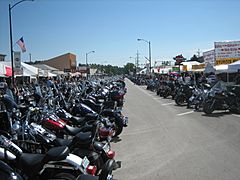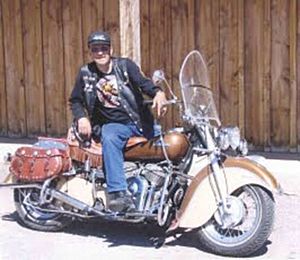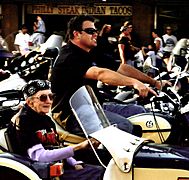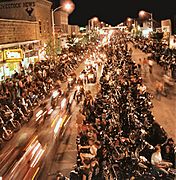Sturgis Motorcycle Rally facts for kids
Quick facts for kids Sturgis Motorcycle Rally |
|
|---|---|

Motorcycles lined up on Main Street during the 2006 event
|
|
| Genre | Motorcycle rally |
| Dates | Starts first Friday in August (for 10 days) |
| Location(s) | Sturgis, South Dakota, U.S. |
| Founded | August 14, 1938 |
| Most recent | August 2–11, 2024 |
| Next event | August 1–10, 2025 |
| Attendance | highest: 739,000 (2015) |
| Website | https://www.sturgis.com/ |
The Sturgis Motorcycle Rally is a huge gathering for motorcycle fans held every year in Sturgis, South Dakota. The event takes place in the town and the nearby Black Hills area. It started in 1938 with a group of Indian Motorcycle riders who wanted to show off their skills in stunts and races.
Today, the rally is a massive 10-day event with activities organized by many different groups. It attracts around 500,000 people each year. In 2015, a record-breaking 739,000 people attended! The rally is a big deal for South Dakota, bringing in about $800 million to the state each year.
Contents
The Story of the Rally
The very first rally, called the "Black Hills Motor Classic," was held on August 14, 1938. It was started by a motorcycle club called the Jackpine Gypsies. The club's founder was Clarence "Pappy" Hoel, who owned an Indian motorcycle shop in Sturgis. For their contributions, both the Jackpine Gypsies club and Pappy Hoel were later honored in the Motorcycle Hall of Fame.
From Racing to a Major Event
In the beginning, the rally was all about racing and stunts. Riders would compete in races on a half-mile track and perform daring tricks. They even did ramp jumps and crashed through wooden walls on purpose!
In 1961, the rally grew to include more types of races, like hillclimbs and motocross. The event has been held every year since it started, except for a few years during World War II.
Originally, the rally was a three-day event. It started with a "Gypsy tour," where riders were guided on a scenic ride through the Black Hills. The next two days were packed with motorcycle races, parades, and dances in downtown Sturgis.
Growing Pains
By the 1980s, the rally had become so popular that tens of thousands of visitors were coming to the small town of Sturgis. The town had to figure out how to handle the large crowds. Over time, the town and the rally organizers worked together to make sure the event was fun and safe for everyone.
For many years, the rally was a seven-day event. But in 2017, it was officially expanded to the 10-day festival that it is today. It now starts on the first Friday of August.
How Many People Attend?
The South Dakota Department of Transportation counts the vehicles that travel to Sturgis for the rally. This helps estimate how many people attend. The number of visitors often goes up for big anniversaries, like the 75th rally in 2015.
It's important to know that "attendance" is an estimate. It's based on things like traffic counts and vendor licenses. Since many people drive in and out of town several times, they might be counted more than once. So, the actual number of people is a bit lower than the official numbers.
Here is a table showing the estimated attendance over the years:
| Year | SDDOT traffic count | Official attendance |
|---|---|---|
| 1990 | 528,676 | 400,000 |
| 1999 | 539,475 | 325,000 |
| 2000 | 604,441 | 633,000 |
| 2001 | 530,667 | 400,000 |
| 2002 | 561,752 | 450,000 |
| 2003 | 605,140 | 502,000 |
| 2004 | 547,370 | 514,951 |
| 2005 | 524,656 | 525,250 |
| 2006 | 449,527 | 456,968 |
| 2007 | 461,507 | 507,234 |
| 2008 | 405,475 | 414,917 |
| 2009 | 394,009 | 442,163 |
| 2010 | 459,968 | 466,769 |
| 2011 | 415,367 | 416,727 |
| 2012 | 445,700 | |
| 2013 | 516,378 | 467,338 |
| 2014 | 442,200 | |
| 2015 | c. 1,000,000 | 739,000 |
| 2016 | c.360,000 | 448,000 – 463,412 |
| 2017 | 376,033–469,100 | 480,000 |
| 2018 | 505,969 | 495,000 |
| 2019 | 499,654 | 490,000 |
| 2020 | 462,000 | 445,000 |
| 2021 | 525,768 | 555,000 |
| 2022 | 497,835 | 505,000 |
| 2023 | 458,161 | 617,000 |
Who Owns the Name "Sturgis"?
For a while, a company tried to claim ownership of the name "Sturgis Motorcycle Rally" through a trademark. This would mean other people couldn't use the name without permission.
However, in 2018, a court ruled that no single group could own the name. The court said the rally is a community event put on by many different people and organizations. The city of Sturgis helps by providing services like police and street cleaning, but it doesn't "own" the rally itself. The judge compared it to New York City providing services for the United Nations, but not owning the United Nations.
Because of this ruling, the name "Sturgis Motorcycle Rally" is free for everyone to use.
Impact of the Rally
The rally has a huge positive impact on the economy of South Dakota. It brings in over $800 million each year. The city of Sturgis also raises money for local charities during the event. In 2019, the rally helped generate over $600,000 for good causes.
With hundreds of thousands of visitors, the town gets very crowded. Roads can look like parking lots, and extra police officers are brought in to help manage traffic and keep everyone safe. The rally is so big that other places have studied it to learn how to manage large crowds for their own events.
Getting to the Rally
Many people ride their motorcycles all the way to Sturgis. But what if you live too far away? Some people fly to South Dakota and have their motorcycles shipped there. Special shipping companies transport thousands of bikes to Sturgis just for the rally.
The Rally on TV
The Sturgis Motorcycle Rally is so famous that it has been featured on many TV shows.
- The show COPS filmed at the rally in 1997.
- From 1996 to 1999, World Championship Wrestling (WCW) held a big event at the rally.
- The animated show King of the Hill had an episode where the characters travel to Sturgis.
- The reality shows American Chopper and Orange County Choppers have filmed many episodes at the rally, often building special bikes to reveal at the event.
- A reality show called ... Saloon showed what it was like to run the world's largest biker bar during the rally.
- The shows American Pickers and Pawn Stars have also filmed episodes in Sturgis during the rally.
Gallery





